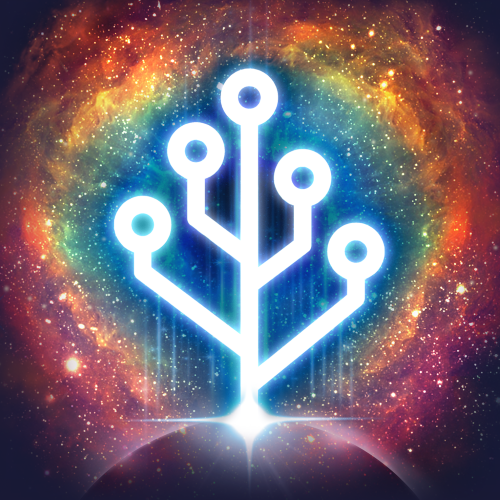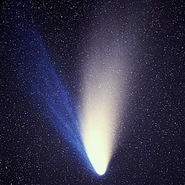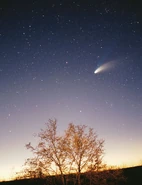Comet Hale-Bopp (cometary designation: C/1995 O1) is the 24th Celestial Body and the 3rd Comet obtained in The Beyond Bubble Universe, which can generate Stardust.
The orbit Hale-Bopp follows in the game is not the same as the real one, since its perihelion (closest approach to the Sun) sits at around 0.9 AU (Astronomical Units), which is still inside the inner solar system. The closest point to the Sun in Cell to Singularity is way beyond Neptune.
In-Game Description[]
"Comet Hale-Bopp was visible with the naked eye for a record-breaking 18 months in 1996 1997. It was one of the brightest comets ever seen by humans, and the most widely observed comet in the 20th century."
Traits[]
Common[]
- Bright Perihelion (Speed):
"Comet Hale Bopp was one of the brightest comets seen in centuries when it reached its perihelion (the point in its orbit closest to the Sun) in 1997. It was so bright it could be seen even in daytime."
- Third Tail (Payout):
"Astronomers had known for some time that comets had two tails, one made of dust and the other of gas. They discovered a third tail, made of sodium, when observing comet Hale Bopp."
Rare[]
- Comets (Payout):
"Comets are small, icy bodies that orbit the Sun and are sometimes visible from Earth. As they get closer to the Sun, the Sun's heat causes them to release gases that form a cloudy aura or tail."
Epic[]
- Speed of Light (Speed):
"The speed of light is the rate at which light and all massless particles travel through a vacuum. While it can seen instantaneous from up close, over long distances this speed limit becomes very noticeable. The theory of relativity relates to the speed of light."
- Cosmic Gravity (Payout):
"Gravity is one of the fundamental forces and key to understanding how the universe works. Using Newton's principles, astronomers can explain how stars and planets form, predict their mass and motion, and infer the existence of dark matter."
- Goldilocks Zone (Discount):
"The Goldilocks Zone, also called the Habitable Zone, is the region around a star with conditions necessary for a planet that can sustain life. Planets like Earth, with surface water and breathable atmospheres, might be found in these zones in other systems."
Achievements[]
- The Great Comet (Rank 5):
"Maybe once every decade, an unusually bright comet will appear in the night sky. Throughout history, these rare astronomical events have been called Great Comets. Humans once considered them omens of important events to come."
- I Want to Believe (Rank 8):
"While observing Comet Hale Bopp, an amateur astronomer incorrectly identified the star SAO1411894 as an unidentified flying object in the comet's wake. This led many conspiracy theorists to conclude that the comet foretold the coming of aliens."
Real Image and Symbol[]
Sources[]
- Comet Hale-Bopp — Real images taken
| | |
|---|---|
| |
Sun • Heliosphere • Alpha Centauri |
| |
Mercury • Venus • Earth • Mars |
| |
Moon • Io • Europa • Ganymede • Callisto • Titan • Enceladus • Triton |
| |
Asteroid Belt • Ceres • Vesta • Kuiper Belt |
| |
Jupiter • Saturn |
| |
Uranus • Neptune |
| |
Pluto • Haumea • Makemake • Eris |
| |
Shoemaker Levy 9 • Halley's Comet • Hale–Bopp |
| |
Sedna • Planet X • Hills Cloud • Oort Cloud |


